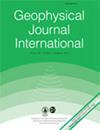利用自回归预测和多分量波形的瞬时相位自动测量远震 P 波、SH 波和 SV 波的到达时间
IF 2.8
3区 地球科学
Q2 GEOCHEMISTRY & GEOPHYSICS
引用次数: 0
摘要
摘要 介绍了一种从多分量地震波形数据中提取全局 P 波、SH 波和 SV 波相位到达时间的新自动算法。该拾取器基于一种顺序方法,使用滑动时间窗中滤波波形的自回归预测、阿凯克信息准则和原始波形的希尔伯特变换。通过将信噪比和高阶统计量合并为一个单一指标来计算单个拾取的质量。合成测试用于找到高质量和低质量阈值。该算法适用于 1990 年至 2019 年期间发生的 6 级或以上远震事件波形的全球数据集。这产生了约 400 万个 P 相到达时间以及约 300 万个 SH 相和 SV 相到达时间。这些自动选取时间与 ISC-EHB 目录中的约 830 000 个人工 P 相选取时间和约 70 000 个人工 S 相选取时间进行了比较。通过使用邻近台站的高质量采样,估算出了自动采样的采样误差上限。结果发现,P 选区的误差上限为 0.55 秒,S 选区的误差上限为 4.3 秒。如果只考虑高质量采样,即 50%的 P-采样和 25%的 S-采样,那么 P-采样的误差将分别降至 0.35s 和 1.5s。作为采样的副产品,到达信号的主周期也被确定下来。本文章由计算机程序翻译,如有差异,请以英文原文为准。
Automated measurement of teleseismic P-, SH-, and SV-wave arrival times using autoregressive prediction and the instantaneous phase of multicomponent waveforms
Summary A new automated algorithm for picking the arrival times of the global P-, SH- and SV-wave phases from multi-component seismic waveform data is presented. This picker is based on a sequential approach using autoregressive prediction of the filtered waveform in a sliding time window, the Akaike-Information-Criterion and the Hilbert transform of the original waveform. The quality of the individual picks is computed by combining signal-to-noise ratios and higher order statistics into a single measure. Synthetic tests are used to find values for high and low quality thresholds. The algorithm is applied to a global data set of waveforms from teleseismic events with magnitude 6 or higher that occurred between 1990 and 2019. This resulted in approximately 4 million P-phase arrival times as well as approximately 3 million SH- and SV-phase arrival times each. These automatic picks are compared to approximately 830 000 manual P-picks as well as approximately 70 000 manual S-picks from the ISC-EHB catalogue. An upper bound for the picking errors of the automatic picks is estimated by using high quality picks of neighbouring stations. This upper bound is found to be 0.55s for the P-picks and 4.3s for the S-picks. If only high quality picks are considered, this represents 50 per cent of the P-picks and 25 per cent of the S-picks, then these errors decrease to 0.35s for the P-picks, and 1.5s for the S-picks, respectively. As a by-product of the picking, the dominant periods of the arriving signals are determined as well.
求助全文
通过发布文献求助,成功后即可免费获取论文全文。
去求助
来源期刊

Geophysical Journal International
地学-地球化学与地球物理
CiteScore
5.40
自引率
10.70%
发文量
436
审稿时长
3.3 months
期刊介绍:
Geophysical Journal International publishes top quality research papers, express letters, invited review papers and book reviews on all aspects of theoretical, computational, applied and observational geophysics.
 求助内容:
求助内容: 应助结果提醒方式:
应助结果提醒方式:


